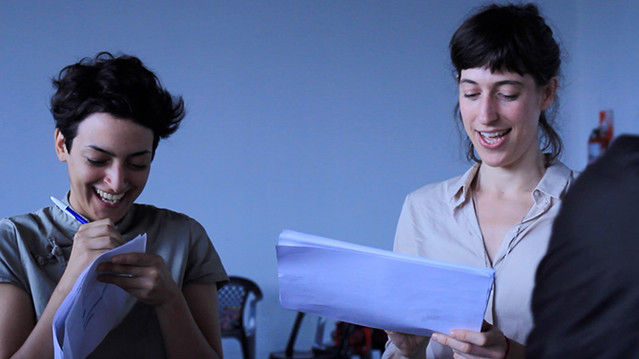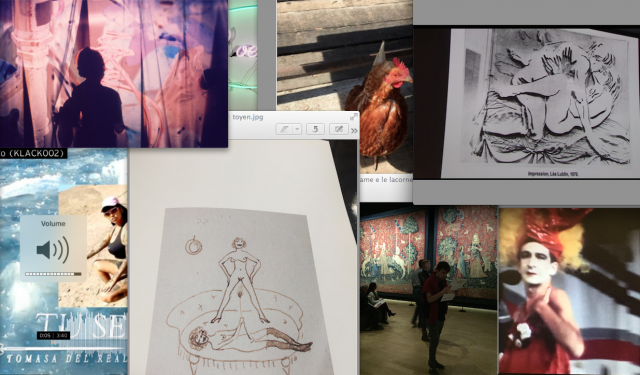Mercedes Azpilicueta / Pernod Ricard Fellowship 2017
In residency in April 2017 and from January to February 2018
Mercedes Azpilicueta is a visual and performance artist from Argentina based in The Netherlands. Drawing on a transdisciplinary approach within her artistic practice, she develops projects that explore the affective qualities of language and voice, the political dimension of female desire, and the connections between embodiment, glocalities and resistance. Her work opts for personal and particular methodologies such as mnemonic and literary techniques, public soundscapes in relation to social and cultural conditions and the use of performative elements for producing knowledge, allowing processes where contingency, association and playfulness take place. In 2015 and 2016 she was a resident at the Rijksakademie van Beeldende Kunsten, Amsterdam. She has a MFA from the Dutch Art Institute/ArtEZ, Arnhem and a BFA from the National University of Arts, Buenos Aires; where she also did the Artist´s Program at Universidad Torcuato Di Tella.
Solo exhibitions include NoguerasBlanchard (Barcelona, 2017), Zmud Projects (Buenos Aires, 2016), Móvil (Buenos Aires, 2015) and Centro Cultural Borges (Buenos Aires, 2009). Group exhibitions and performances include a.o. Centro de Arte 2 de Mayo (Madrid, 2017), Chinese European Art Center (Xiamen, 2017), Onomatopee (Eindhoven, 2016), TENT (Rotterdam, 2015), Irish Museum of Modern Art (Dublin, 2014), Het Veem Theatre (Amsterdam, 2014), Van Abbemuseum (Eindhoven, 2013), Galata Fotoğrafhanesi (Istanbul, 2013), The Poetry Readings Program, Documenta13 (Kassel, 2012), and Raw Material Company (Dakar, 2012). In 2018 she will present her first major solo exhibition at the Buenos Aires Museum of Modern Art.

- Todo afuera adentro (All Outside Inside), 2015, performative installation, variable dimensions., Interprètes : Natalia Albero, Jair Almar, Paula Campana Cristal, Liza Casullo, Sol Crespo, Rochi Gallardo, Marina Lazo, Malena Ledesma, Marina Mariasch, Graciela Montoya, Edgar Robba, Liv Schulman et Gabino Torlaschi. Musical advisor : Osvaldo Ledesma. Móvil, Chela, Buenos Aires, April, 25 - June, 6 2016. Courtesy of Ramiro Iturrioz.
PROJECT PRESENTATION
During the first part of her residency in April 2017, Mercedes Azpilicueta developed a research into several artistic figures and trajectories, through meetings with art historians and critics, visits to museums and archive, and long strolls through the city and its underground — which she perceived as a place of collective resistance, where bodies perform differently from overground. She wrote a diary, hells, smells & shame, which served both as a draft script.
During the second part of her residency in January & February 2018, Mercedes Azpilicueta will develop a script for a filmed performance, based on a series of working sessions with choreographer Pauline Simon, Jean-Baptiste Veyret-Logerias (performer and performance maker, and a practitioner of perceptive somatic-psychoeducation), performer Emmanuelle Lafon, theorist Myriam Suchet and curator Virginie Bobin (Villa Vassilieff) ; as well as on collective workshops with students from Paris 8 University, Paris 3 – Sorbonne Nouvelle University, and Fondation Maison des Sciences de l’Homme. Additional workshops will take place at Cité Internationale des Arts on February 2 & 3 as part of We Are Not the Number that We Think We Are, a 36-hour event produced by Bétonsalon - Center for Art and Research & Villa Vassilieff.
Mercedes Azpilicueta will also produce a series of props and « visual mnemonics » in collaboration with artist and designer Lucile Sauzet.
Parts of these activities will be recorded in collaboration with film-maker Hélène Harder, with the aim of producing a film in the course of the year 2018.
A work by Mercedes Azpilicueta, Pink popping plank, is presented in the exhibition Akademia : Performing Life, on view at Villa Vassilieff from January 13 to March 24, 2018. Curated by Solvita Krese & Inga Lāce (Latvian Center for Contemporary Art).
The work is all at once a sculpture, a set, a script, a score, and will be activated during a series of workshops taking place in the exhibition.
ABOUT HELLS, SMELLS & SHAME
Notes from April 2017
“(…) we feel intoxicated. our bodies feel intoxicated. our parisian bodies, tourist bodies, homeless bodies, european bodies, african bodies, foreign bodies, digital bodies, latino bodies, heteronormative bodies, old bodies, soft bodies, hard bodies, young bodies, queer bodies, worked-out bodies, fancy bodies, dirty bodies, sweaty bodies, all these different and individual bodies feel intoxicated. we start to vibrate. maybe not all of them do, but i want to imagine that all of them do. and they do. all kinds of different bodies down here are being shaken at the same time.”
about hell, smells & shame is a diary that I wrote during the first part of my residency at Villa Vassilieff in April 2017. The diary addresses different thoughts related to the body and affects, the senses and the underground as a place for resistance. Referencing the work by Argentine-French performance artist Lea Lublin, the series of enigmatic tapestries La dame à la licorne, the literary aesthetics of the Neobarroso Rioplatense, Chilean reggaeton, imaginary characters and vagabonds from the infra-world, and terms such as anthropophagic subjectivity and auto-historias - coined by Suely Rolnik and Gloria Anzaldúa respectively -, the project unfolds during the second part of the residency -in January and February 2018- in a group of works that develops in different stages. The different stages include a performance, a series of scripts, video/s and sound pieces. First, the diary is a starting point for making the scripts that accompanied by images and symbols, will become spatial modules or props for the performance, as well as ayuda-memorias (or visual mnemonics) for the choreography and the dramaturgy of the work. Second, the scripts and performance will inform the development of the rest of the works, the video/s and sound pieces, to be produced in a later stage. A group of collaborators including a choreographer, a vocalist, a video-editor and performance artists will also be part of the process. ”

- about hell, smells & shame , research documentation. Courtesy Mercedes Azpilicueta
STATEMENT OF INTENT
October 2016
“During my residency at Villa Vassilieff, I will research the political dimension of desire in relation to affects; the biocultural, biodigital and biophysical body; and gender dissent in an aesthetic context. What are the affects that compose a body and how can these affects enter into a new composition with the affects of another body? To broaden my investigation, I will work with a concept coined by Suely Rolnik, anthropophagic subjectivity, and its possibilities to connect to the political dimension of desire from a de-colonial perspective. (…) I believe a practice based on an anthropophagic subjectivity can develop de-colonial aesthetics in order to break away from modern knowledge, so rooted in colonial history. Overall, an anthropophagic and political subjectivity could create a space for inventing other common, shared, collective forms that we could inhabit together, far from the modern truth-value assigned to a particular narrative.
In the second part of my research, I would like to investigate the modern legacy in Paris, especially female artists and artists who have subverted the gender binary such as Valentine de Saint-Point, Natalia Goncharova and Valeska Gert to mention a few. From these archives I would like to choose the material that has a connection to voice, sound and to the affective quality of language. I would like to see how these references can be re-visited through an anthropophagic subjectivity and therefore, to be de-modernized. (…)”
Share